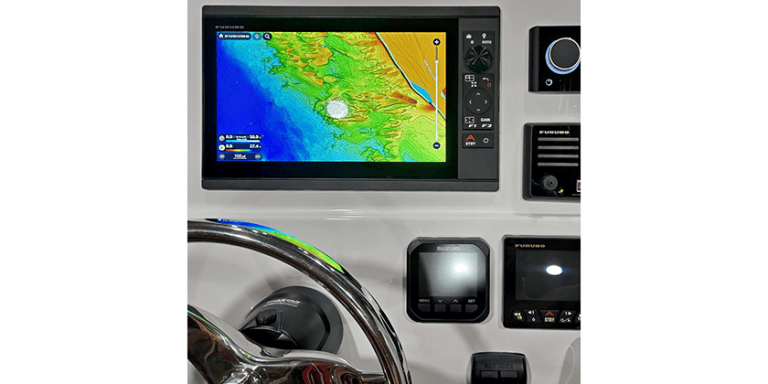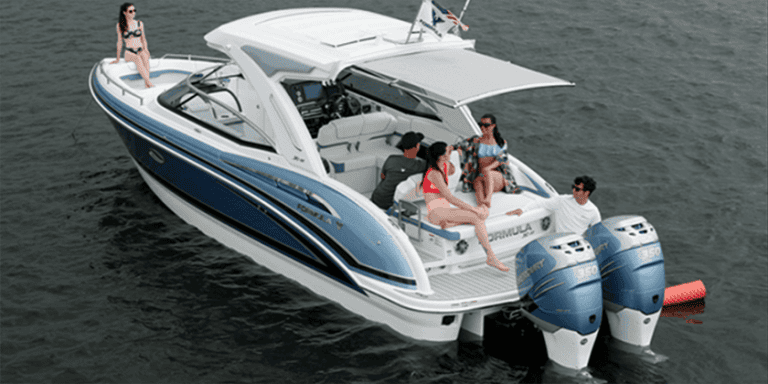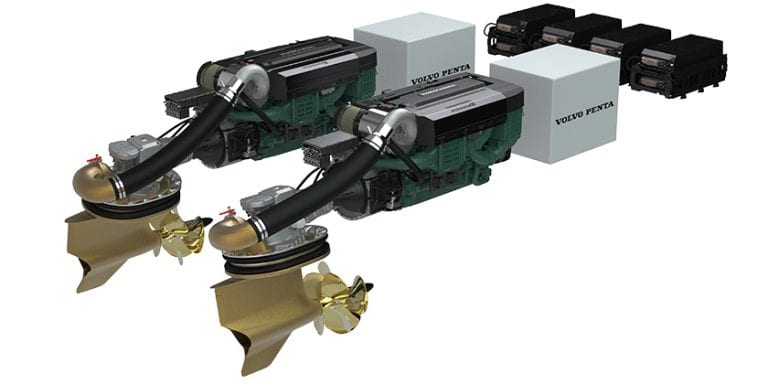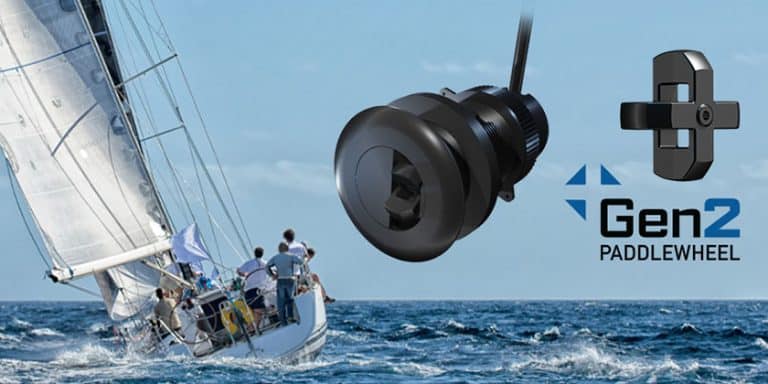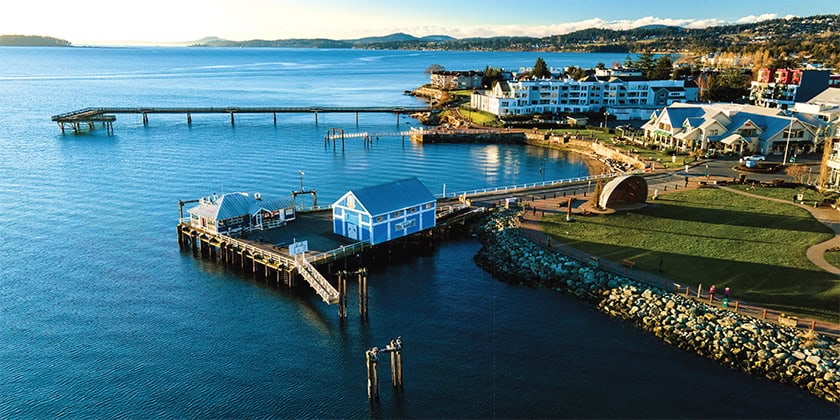User Benefits Of Navigation Electronics At The Helm On A 40’ Power Cruiser
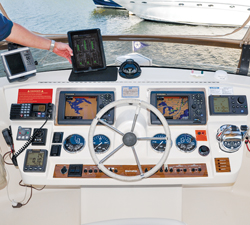
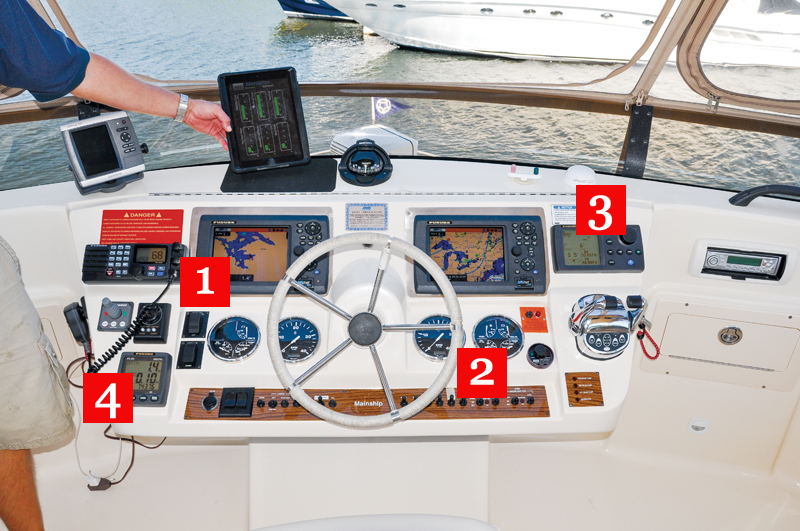
What The Latest Electronics Can Do For You!
Nicely laid out and easily learned, the flying bridge on this Mainship 40 has it all!
BENEFIT: NMEA 2000 Helps All The Components Work Together
Networking: In today’s installations, all systems and instruments can be connected by “backbones” of cables that carry data using protocols such as NMEA 2000 or Raymarine’s proprietary SeaTalk NG. These interfaces greatly simplify installation while improving system reliability. They may also allow owners to mix and match component from different manufacturers to meet specific requirements.
For people with NMEA 0183 equipment, there are “gateways” available to convert into NMEA 2000. So you can upgrade and still maintain important existing equipment.
The cockpit of the Beneteau 43 pictured on page 30 and 31 is absolutely typical of the sort of installation Brad Marchant at FYS outlines. A single Raymarine E120 MFD is mounted on a pivoting pod at the aft end of the cockpit table so it can be angled for viewing from either of the two steering stations. It displays GPS, charting and AIS data. Raymarine ST60+ Tridata (speed/depth/log) and wind speed/direction displays are mounted by the portside wheel, while an ST60+ repeater and an ST6002 SmartPilot control head live at the starboard wheel. A remote VHF mike is mounted on the inner side of the starboard console.
An interesting wrinkle of this installation was that while the boat had no instruments at the lower nav station other than a VHF radio, a large bulkhead-mounted Sony flat-screen TV can act as a repeater for the cockpit MFD, controlled by a keyboard that hides inside the chart table. Everything, but everything, can be interfaced…right?
Now we have come aboard a Mainship 40 that has been totally re-fitted for long distance cruising by Brian Kelly and his team at Bayland Enterprises in Georgian Bay, Ontario.
#1. NMEA2000
BENEFIT: Choose The Information You Want, When You Want It
Here, the chart plotters (MFDs) are all tied to an NMEA2000 backbone by Maretron and virtually all the components onboard can “talk” to each other. A pair of Furuno MFD 8s which are NavNet 3-D multi-function displays, can display the information from all the other components because through the NMEA2000 backbone, they are all tied together, although this boat had no Fish Finder module. If the owners decided they wanted to take up fishing, they can later and easily add an NMEA2000 Fish Finder component.
Also, these chart plotters are using Jeppesen cartography, but again, the owners can change if they want. Again, there is also a weather overlay from Sirius satellite that gives a tremendous wealth of weather detail including such valuable things as wave height. This boat has a Furuno weather station called a BBWX2. The information can show on your MFDs can help you decide if you want to spend your day on the water. The benefits is that you can anticipate weather fronts by checking the wind speed and direction, temperature, and barometric pressure. Note: You need a United States address for billing in order to get Sirius satellite information.
This boat also has a 4 kW high-definition radar under a radome. Like the sailboat on page 30 and 31, the radar can help you “see” your way in the dark or in fog.
Again, the MFDs can display the AIS information revealing other vessels in the area even in darkness or fog. Another handy function is that the MFDs can switch to display digital engine data.
What is most important is that that whole range of information and more, can be quickly and easily selected to display on either screen. So, show your course on a map on one screen, overlay additional information like AIS or a radar sweep for collision avoidance and show engine data or depth sounder readings on the other screen; what ever you want, when ever you want it.
#2. Engine Instruments
BENEFIT: Engine Information The Way You Are Used To Seeing It
The traditional analog engine instruments are a fast and familiar way to convey engine information. It’s easy to see when a needle is out of whack.
#3. Autopilot
BENEFIT: Precise Course Steering For Greatest Efficiency
This boat has an autopilot which ties into the NMEA2000 system so if you have a NMEA 2000 backbone, you can tie your compass and even a black box in the salon back into the network to all work together.
This allows you to set in the course on one of the multifunction displays. You simply press “go to”, then to autopilot, to navigate, to go to, to waypoint, to yes. When you arrive at that waypoint, the system asks you for the next waypoint. Also, if you had the Max Sea computer program for PC you could plan your vacation and chart your trip at home or even in the comfort of the salon of your boat and then plug it into the hub and download your planned route to the navigation system and the autopilot will take you there.
#4. Digital Repeater
BENEFIT: Keep Critical Information In View
Digital Repeater: This boat has an FI50 digital repeater. This gives critical information such as depth, speed over ground, wind information and more. A repeater is useful to have because it is a simple way for people to show their speed over ground or other information compared to sacrificing space on their multifunction display where they are otherwise following the route maps. The repeater controls lots of information such as water temperature, air temperature, air pressure, dewpoint information, distance traveled, timing and more.
Some boaters always like to see a big readable display to show for example, the water depth while they are otherwise navigating with the bigger screens.
This boat has a VHF radio and it ties into the chart plotter using NMEA 0183. That’s how it gets your GPS position, latitude, longitude and the information for the Digital Selective Calling, DSC function. To facilitate that, owners need to apply to the government to get a mobile maritime service identification number, MMSI. This supplies a lot of information that is then broadcast out giving information about your vessel, your position, who you are and much more plus it facilitates automatic distress calling with a simple press of one button.
AIS on the chart plotter is MMSI-based and other boats can also see you through this system as well as you seeing them. You can learn what kind of vessel they have, whether they are recreational boats or commercial shipping center sharing the same space and more.
Brian Kelly showed me an AIS readout from around the world using his iPad. This was very impressive. Every boat equipped with AIS shows up all around the world and it is mandatory in some areas. Incredibly, we could go to any harbour in the world and find the AIS equipped vessels. The entertainment value alone is worth the price but if nothing else, it might prevent you from being hit.
BENEFIT: A Wealth Of Information
Today’s electronics suites can deliver a wealth of information to make your boating experiences more convenient, entertaining and safer too. The Mainship 40 we were on had a Maretron N2KView system using NMEA 2000. This then supplies such diverse information as the state of the battery banks, temperatures, charging levels [for example 12.9 V on the flowchart equals a 100% fully charged battery. This can also display 20% or 30% left etc.
With the fuel management package, you can see how much fuel you have used so you can determine the “sweet spot” for the boat’s best fuel economy, the percentage of fuel left until empty and so on.
This boat is also equipped to monitor all of its tank levels for fuel, water, gray water, waste holding tanks and also the levels in the starboard tanks compared to the port tanks to keep the vessel trimmed. Finally, this boat has a remote control spotlight and also track vision satellite television.
It’s well rigged for long-distance cruising to best cope with any weather or navigation situations as well as to monitor all mechanical systems to avoid a breakdown or problem.
Incidentally, the National Marine Electronics Association (NMEA) has created a brochure to educate boaters about the possible hidden costs of purchasing marine electronics based on price alone. It’s called A Guide to Boating Electronics: What You Should Know When Buying Electronics for Your Boat.
The Guide points out that while buying marine electronics from a mass marketer may be cheaper initially than buying from a dealer with trained technicians, the overall cost could turn out to be much greater for the cheaper electronics because of unanticipated repairs, reworking, or replacement later on. Only NMEA-trained technicians can provide the expert advice boaters need to ensure proper selection and installation of the electronics they purchase. Boaters can also count on the companies that employ these technicians for service and warranty support after the sale.
You can get a free copy of the Guide by visiting www.nmea.org or by contacting the NMEA office at 410-975-9425.
Written by a collaboration between Andy Adams and Brian Kelly


